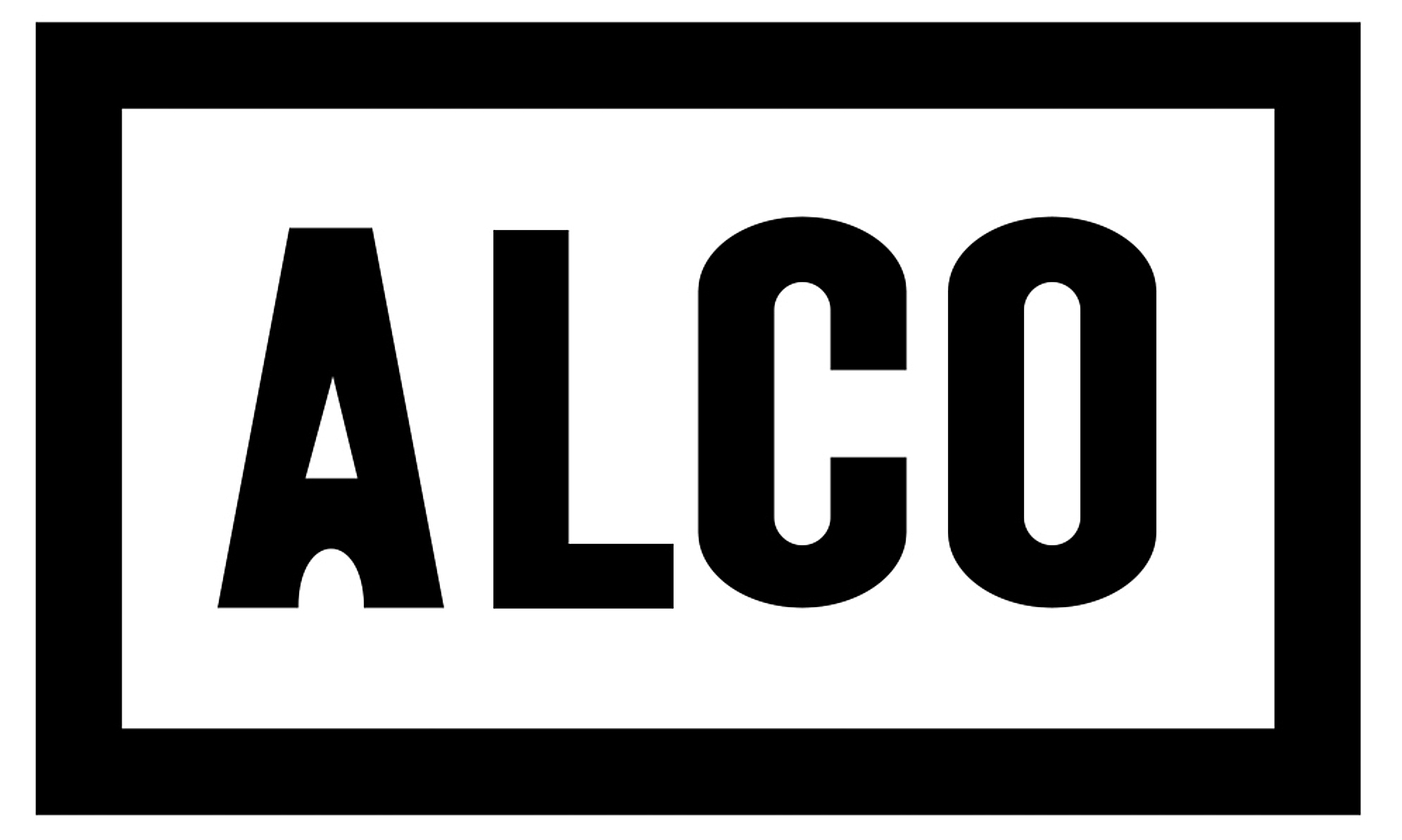American Locomotive Company (Alco): History, Logo, Location
Last revised: August 25, 2024
By: Adam Burns
The American Locomotive Company, also known as Alco, at one time was one
of the two preeminent locomotive builders in the country behind only
Baldwin Locomotive Works.
Of course, this was the days of steam locomotives and while Alco would eventually build more than 75,000 locomotives (most of which were steamers) its success in the diesel era was not quite as impressive.
And, even though Alco would fold as its diesel sales fell in the 1960s and fell to third place behind General Electric, the company would produce some of the most unique and interesting models to ever roam the rails.
History
Interestingly, as a testament to Alco's manufacturing techniques several of its models built as early as the late 1930s continue to operate today, some still in revenue service on short lines.
Few other classic first-generation diesel models are as fondly remember as Alco's. The manufacturer produced some very tasteful designs, albeit not necessarily reliable ones.
Models like the RS-1 kicked off the road-switcher variant while the RS-3 featured beveled edges and good looks. Their cab designs were also very classy and the PA has been described as one of the most beautiful of its type ever built.
Photos
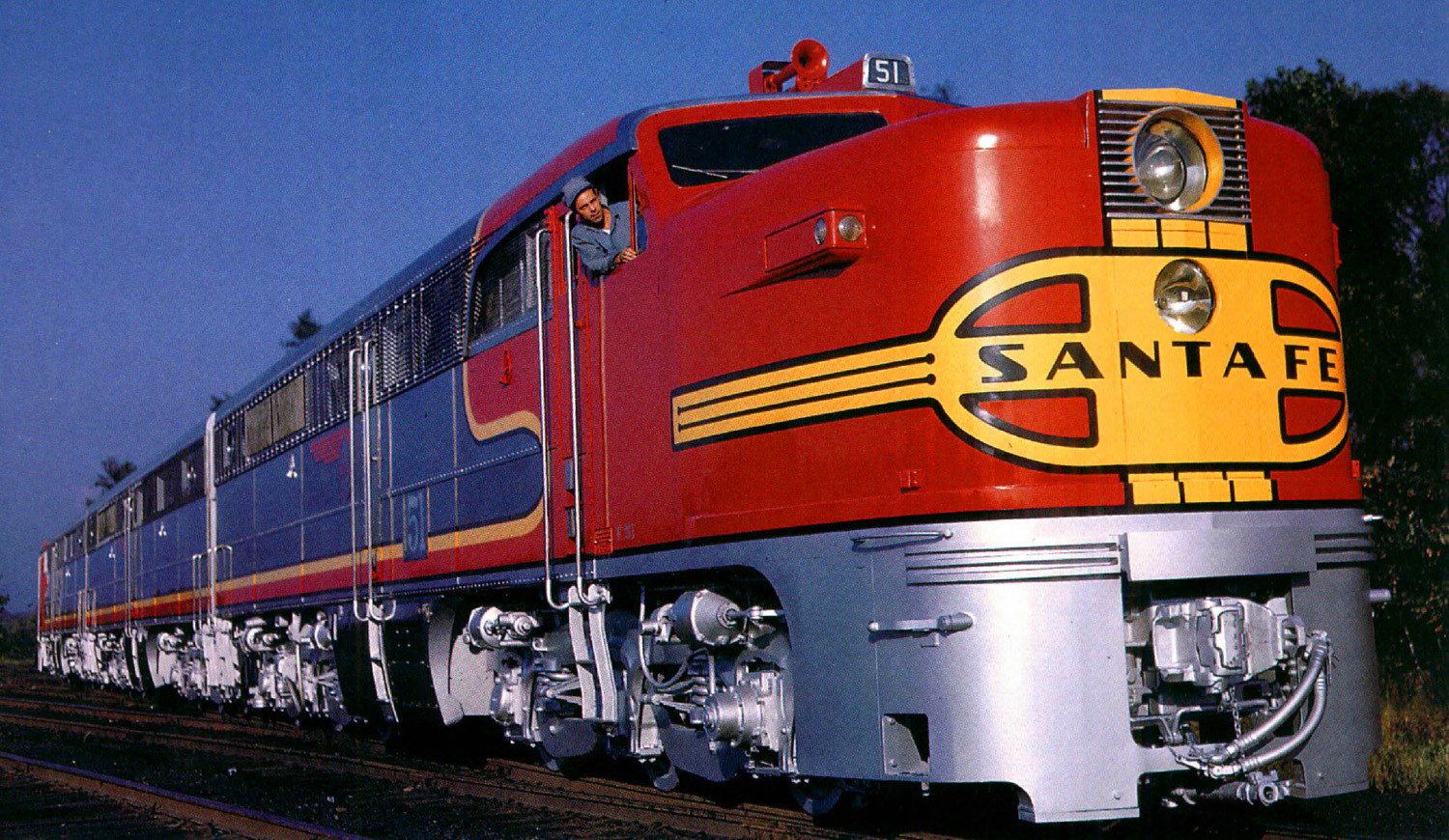 An Alco photo showcasing a brand new set of Santa Fe PA-1's (and PB-1), circa 1946. The AT&SF wasn't particularly thrilled with their performance and never followed up for the later PA-2.
An Alco photo showcasing a brand new set of Santa Fe PA-1's (and PB-1), circa 1946. The AT&SF wasn't particularly thrilled with their performance and never followed up for the later PA-2.Predecessors
The American Locomotive Company was actually formed through the combination of several smaller companies in 1901. These companies included:
- Dickson Manufacturing Company
- Brooks Locomotive Works
- Cooke Locomotive & Machine Works
- Schenectady Locomotive Works
- Manchester Locomotive Works
- Richmond Locomotive Works
- Pittsburgh Locomotive & Car Works
- Rhode Island Locomotive Works
Three years later in 1904 the company acquired the Locomotive and Machine Company of Montreal, renaming it the Montreal Locomotive Works (MLW). Except for the Montreal plant and the Schenectady, New York operation all other predecessor facilities were closed with the company's main headquarters being located in Schenectady.
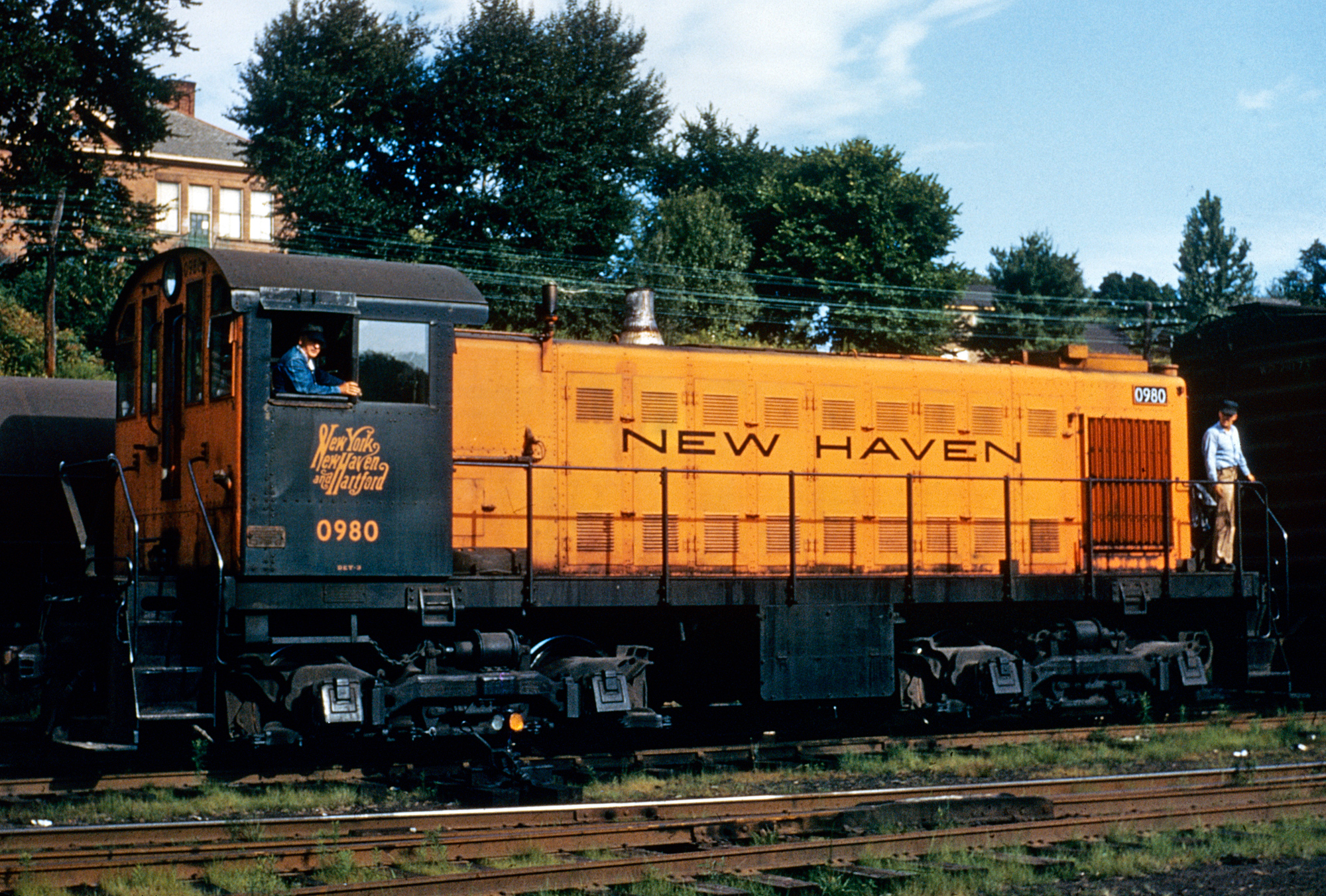 New Haven S1 #0980 carries out switching chores during the 1950s. Location not recorded. American-Rails.com collection.
New Haven S1 #0980 carries out switching chores during the 1950s. Location not recorded. American-Rails.com collection.Steam Locomotives
Alco quickly gained a reputation for not only building high quality steam locomotives but also incorporating new technologies into its designs.
While Alco built scores of early steamers such as 2-8-0 Consolidations and 4-6-0 Ten-Wheelers, the builder was perhaps most famous for some of the later wheel arrangements it manufactured such as the 2-8-4 Berkshires, 4-6-4 Hudsons, 4-8-4 Northerns and others.
Logo
Alco also would build several of the massive articulated designs such as Union Pacific's 4-6-6-4 Challengers and the behemoth 4-8-8-4 Big Boy.
In 1930 Alco produced the first steam locomotive, a 4-8-4 Northern, to operate with rolling bearings in conjunction with the Timken Roller Bearing Company which considerably reduced maintenance and wear on a locomotive's running gear, especially the axles.
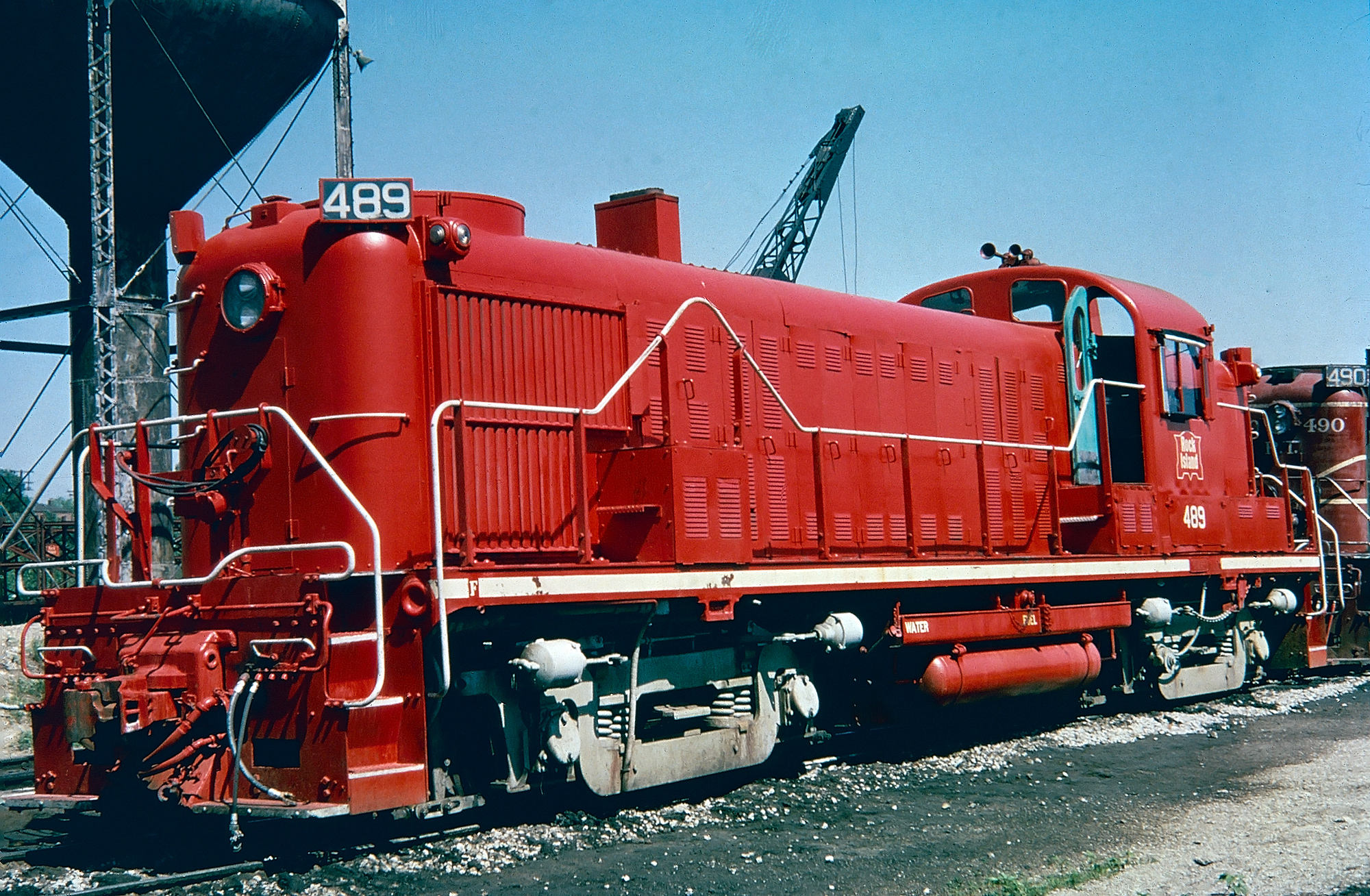 Rock Island RS3 #489 lays over in Blue Island, Illinois between commuter assignments, circa 1967. The railroad used these locomotives extensively in such service well into the 1970s. American-Rails.com collection.
Rock Island RS3 #489 lays over in Blue Island, Illinois between commuter assignments, circa 1967. The railroad used these locomotives extensively in such service well into the 1970s. American-Rails.com collection.While the company was most successful building steam locomotives it is perhaps best remembered for its diesel locomotives. Diesel-electric locomotives have been around in one shape or form since the mid-1920s when Alco jump started the market for them.
The company joined with General Electric and Ingersoll-Rand to produce a 300 hp, 60-ton model in 1924 that would be purchased by the Central Railroad of New Jersey, followed by the Baltimore & Ohio Railroad.
During the 1930s Alco was at the leading edge of diesel locomotive technology, which is rather ironic considering it would slowly fall behind and lose market share to both General Electric and GM's Electro-Motive Division in the following decades.
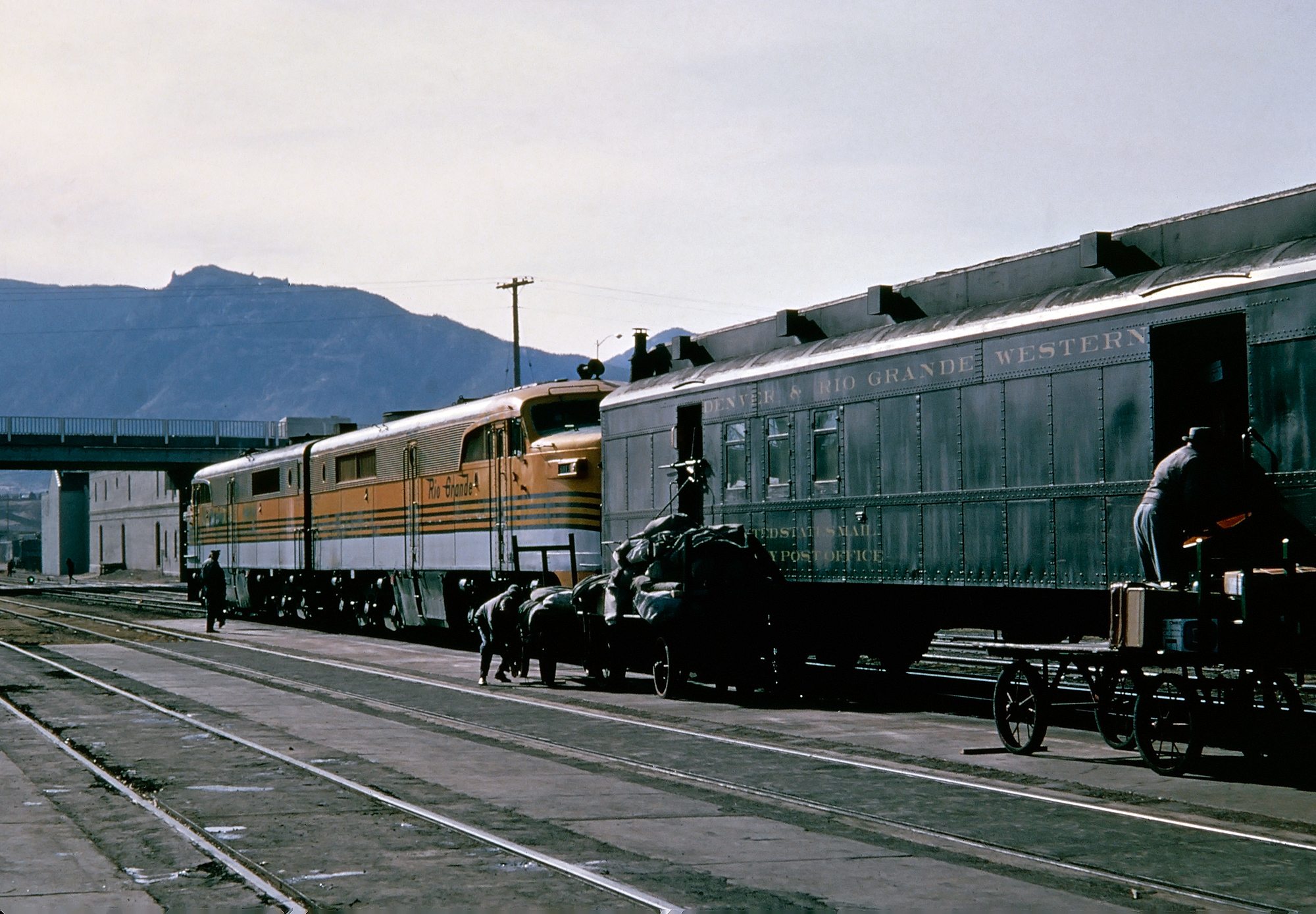 With PA-1's #6011 and #6013 on point, Rio Grande's "Royal Gorge" takes on mail at the joint Rock Island/D&RGW depot in Colorado Springs on December 31, 1964. American-Rails.com collection.
With PA-1's #6011 and #6013 on point, Rio Grande's "Royal Gorge" takes on mail at the joint Rock Island/D&RGW depot in Colorado Springs on December 31, 1964. American-Rails.com collection.The American Locomotive Company's first true production diesel locomotive was the DL-103 (the "DL" stood for diesel locomotive), a streamlined end-cab design similar to then-EMC's (Electro-Motive Corporation) EA model of 1937.
However, unlike the EA the DL-103 was neither as reliable or as aesthetically well-defined, with a much longer, and lower nose. The unit used Alco's 539T prime mover, which was a four-stroke diesel that produced 2,000 horsepower.
Eventually Alco would produce four different models, which varied slightly. Aside from the DL-103 they included the DL-105, DL-107, and DL-109 (which was the most successful garnering 62 units produced). Alco also produced two models of cabless "B" units the DL-108 and DL-110 that only saw four total sales.
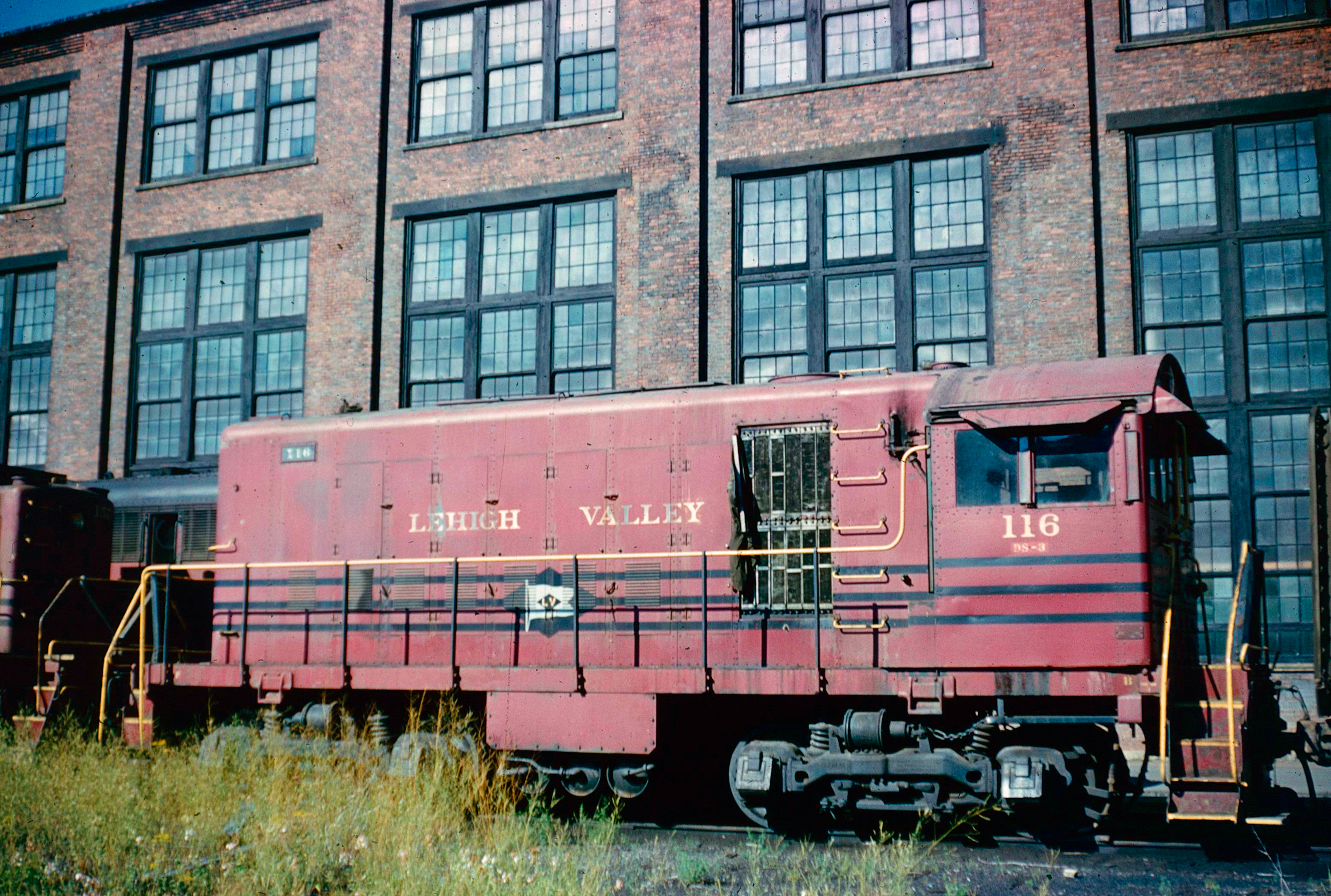 One of the Lehigh Valley's early Alco switchers (600 horsepower) is seen here next to the shops in Sayre, Pennsylvania during August of 1962. Author's collection.
One of the Lehigh Valley's early Alco switchers (600 horsepower) is seen here next to the shops in Sayre, Pennsylvania during August of 1962. Author's collection.In all the DL series was unsuccessful selling only 78 A and B units total, and was a microcosm of Alco's problems with main line passenger and freight diesel locomotives.
Railroads often found the company's prime movers, particularly the 539 (which the DL-100 series was powered with), 241, and 244 models unreliable, troublesome, and rather complicated to maintain. Even in later years when Alco developed a more reliable prime mover, the model 251 it appears the damage was already done amongst railroads.
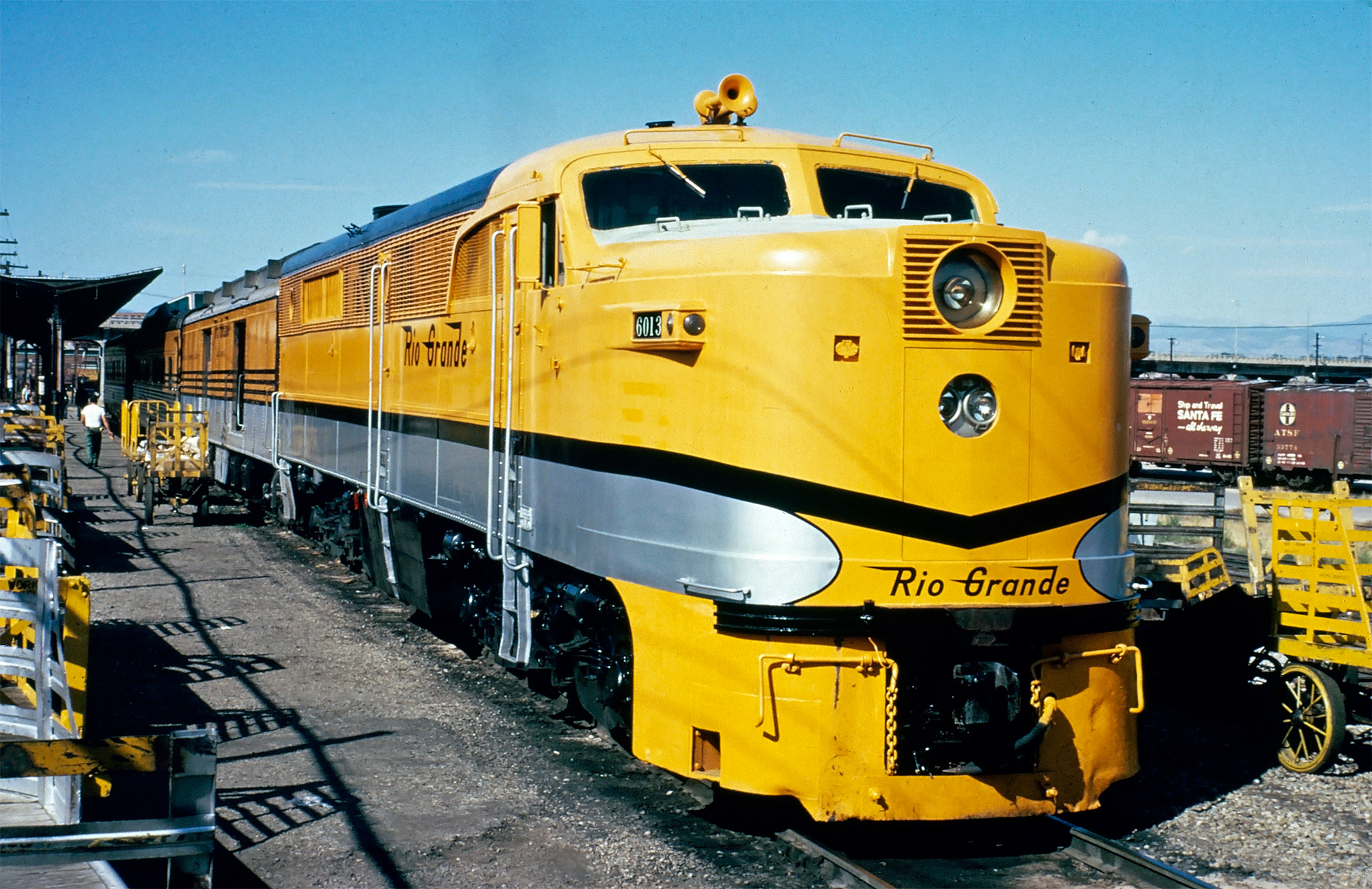 Rio Grande PA-1 #6013 awaits departure from Denver, Colorado with train #9, the westbound "Yampa Valley," circa 1966. Robert Eastwood, Jr. photo. American-Rails.com collection.
Rio Grande PA-1 #6013 awaits departure from Denver, Colorado with train #9, the westbound "Yampa Valley," circa 1966. Robert Eastwood, Jr. photo. American-Rails.com collection.Clearly, Alco's most successful diesel locomotive lines were its switchers and early road-switchers, beginning with the S-1 and RS-1 models. The S-1 was listed in Alco's catalog in 1940 while the RS-1 followed a year later.
The S series (the "S" stood for switcher) would wind up selling over 3,000 units by the time production ended while the RS series (the "RS" stood for road switcher) would sell nearly 1,800.
Overview
* Officially, the Schenectady plant exited locomotive manufacturing on this date. However, the facility completed a few final units beyond that time. These included Newburgh & South Shore Railway T-6's #1016-1017 (construction numbers S-6017-01 and S-6017-02), which rolled out of the plant on January 8 and January 10, 1969.
In addition, the Montreal Locomotive Works continued to build new products under its original name (slightly modified as MLW-Worthington in December, 1964 when the division was acquired by Studebaker-Worthington) until June 23, 1978 when new owner Les Entreprises de J. Armand Bombardier, Ltd. of Valcourt, Quebec (which had acquired MLW Worthington, Ltd. in 1975) dropped the MLW name to become simply Bombardier Incorporated, Rail and Diesel Products Division. Locomotives continued to be produced at the Montreal plant with Alco/MLW lineage until 1985.
What is ironic is that the S series models (of which there were four built the S-1, S-2, S-3, and S-4 with all being very similar) used Alco's troublesome 539 model prime mover and the RS series (the RS-1, RS-2, and RS-3) was powered with the likewise fickle 244 model.
However, these engines performed well in Alco's smaller switcher models but not so in the main line models like the PA and FA. Alco's PA and FA models (the PA was the passenger model while the FA was for freight service) debuted in 1946 and were the company's answer to EMD's wildly successful E and F series cab units.
Unfortunately, they were equipped with Alco's new 244 model prime mover which was meant to replace the troublesome 539.
Worthington Corporation
In December, 1964 American Locomotive was acquired by the Worthington Corporation, which became Studebaker-Worthington Incorporated in 1967 when Worthington purchased the Studebaker Corporation, a well-known automobile manufacturer based in South Bend, Indiana.
Following the end of locomotive production at Schenectady, Worthington broke up Alco into several divisions in an attempt to sell each component separately. These included
| Name | Purpose | Disposition |
|---|---|---|
| Alco Engine, Inc. | Diesel Engine Manufacturing (Auburn, New York) | Acquired by White Motor Company in 1971. Later purchased by General Electric Company Ltd. of England in 1977 (no affiliation of GE). |
| Alco Products Services, Inc. | Spare Parts Division | Acquired by White Motor Company in 1971. |
| Alco Locomotive, Inc. | Closed, 1969. | Closed |
| Alco Springs Industries, Inc. | Manufactured Springs (Chicago Heights, Illinois) | Closed, 1969. |
| Finserv Computer Corporation | Schenectady Computer Center | Continued to serve Studebaker-Worthington. |
The engine had been rushed into production and proved to be just as unreliable as the 539. The FA would go on to sell just over 800 units while the PA, despite being one of the most beautiful diesel locomotive designs ever conceived, sold just over 200 units.
Both models were later re-engined with Alco's much more reliable 251 model but by that point the damage of the company's reputation had already been done with two failed prime mover designs.
In the early 1960s the American Locomotive Company made one final attempt to keep a respectable market share in the locomotive industry by unveiling its Century series, which were main line freight units of B-B and C-C trucks (four and six axles).
By this time General Electric had already taken over second place from Alco after ending its relationship with the company in 1950 (before that time both corporations teamed up to produce diesel locomotives).
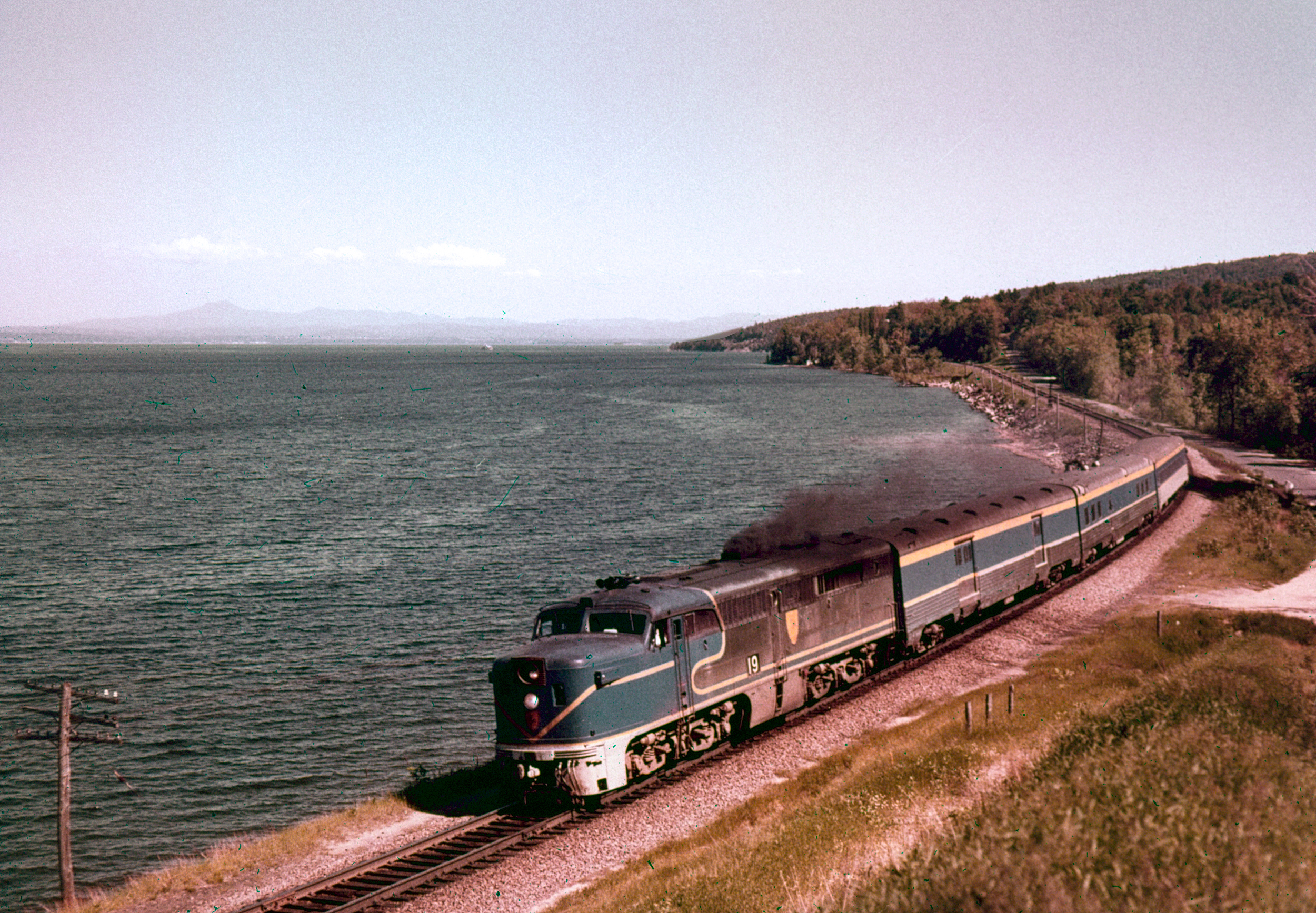 With a little turbo lag, Delaware & Hudson PA-1 #19 leads the northbound "Laurentian" along Lake Champlain at Port Kent, New York on June 10, 1969. Jim Shaughnessy photo. Author's collection.
With a little turbo lag, Delaware & Hudson PA-1 #19 leads the northbound "Laurentian" along Lake Champlain at Port Kent, New York on June 10, 1969. Jim Shaughnessy photo. Author's collection.In 1963 Alco introduced the C-420 and C-628 (the first number designated the number of wheels per truck while second two numbers highlighted the horsepower) to compete with GE's relatively new Universal series and EMD's soon-to-be-released second generation models like the SD35 (which entered EMD's catalog in 1964).
Diesel Models
DL Series
| Model Type | Units Built | Date Built | Horsepower |
|---|---|---|---|
| DL-103b | 1 | 1939 | 2,000 |
| DL-105 | 3 | 1939-1942 | 2,000 |
| DL-107 | 8 | 1939-1942 | 2,000 |
| DL-109 | 62 | 1942-1945 | 2,000 |
S Series
| Model Type | Units Built | Date Built | Horsepower |
|---|---|---|---|
| S-1 | 550 | 1940-1950 | 660 |
| S-2 | 1,500 | 1940-1950 | 1,000 |
| S-3 | 292 | 1950-1957 | 660 |
| S-4 | 782 | 1950-1961 | 1,000 |
| S-5 | 7 (Built for B&M) | 1954 | 800 |
| S-6 | 126 | 1955-1960 | 900 |
| T-6 | 57 | 1958-1969 | 1,000 |
RS Series
| Model Type | Units Built | Date Built | Horsepower |
|---|---|---|---|
| RS-1 | 417 | 1941-1960 | 1,000 |
| RSD-1 | 257 | 1942-1946 | 1,000 |
| RS-2 | 469 | 1946-1950 | 1,500-1,600 |
| RSC-2 | 81 | 1946-1950 | 1,500-1,600 |
| RS-3 | 1,370 | 1950-1956 | 1,600 |
| RSD-4 | 36 | 1951-1952 | 1,600 |
| RSD-5 | 204 | 1952-1955 | 1,600 |
| RSD-7 | 29 | 1954-1956 | 2,250-2,400 |
| RS-11 | 426 | 1956-1964 | 1,800 |
| RSD-12 | 161 | 1956-1963 | 1,800 |
| RSD-15 | 87 | 1955-1960 | 2,400 |
| RS-27 | 27 | 1959-1962 | 2,400 |
| RS-32 | 35 | 1961-1962 | 2,000 |
| RS-36 | 40 | 1962-1963 | 1,800 |
FA Series
| Model Type | Units Built | Date Built | Horsepower |
|---|---|---|---|
| FA-1 | 432 | 1946-1950 | 1,500 |
| FA-2 | 395 | 1950-1956 | 1,600 |
PA Series
| Model Type | Units Built | Date Built | Horsepower |
|---|---|---|---|
| PA-1 | 170 | 1946-1950 | 2,000 |
| PA-2 | 28 | 1950-1952 | 2,250 |
| PA-3 | 49 | 1952-1953 | 2,250 |
Century Series
| Model Type | Units Built | Date Built | Horsepower |
|---|---|---|---|
| C-415 | 26 | 1966-1968 | 1,500 |
| C-420 | 131 | 1963-1968 | 2,000 |
| C-424 | 190 | 1963-1967 | 2,400 |
| C-425 | 91 | 1964-1966 | 2,500 |
| C-430 | 16 | 1966-1968 | 3,000 |
| C-628 | 186 | 1963-1968 | 2,750 |
| C-630 | 133 | 1965-1969 | 3,000 |
| C-636 | 83 | 1967-1968 | 3,600 |
| C-643DH | 3 (Built For SP) | 1964 | 4,300 |
| C-855 | 3 (Built For UP) | 1964 | 5,500 |
While the new models were equipped with Alco's much more reliable 251 prime mover (more specifically the 251C) the damage to the company's reputation of unreliable locomotives had already been done.
In total the C-400 series sold just 297 units while the C-600 series sold 348. In comparison, EMD's original SD40 model of 1966 outsold both models by more than two-fold at 1,257 units.
With the Century series unsuccessful the American Locomotive Company gave up on the locomotive market and closed its Schenectady operation in 1969.
The company's locomotive designs were sold to its Montreal Locomotive Works division (which was eventually purchased by Bombardier in 1975 and dissolved in 1978) and its engine schematics would eventually wind up with Fairbanks-Morse, a one-time diesel locomotive manufacturer itself, which continues to build Alco-inspired engines to this day.
Sources
- Kirkland, John F. Diesel Builders, The: Volume Two, American Locomotive Company And Montreal Locomotive Works. Glendale: Interurban Press, 1989.
- Marre, Louis A. Diesel Locomotives: The First 50 Years, A Guide To Diesels Built Before 1972. Milwaukee: Kalmbach Publishing Company, 1995.
- Schafer, Mike. Vintage Diesel Locomotives. Osceola: MBI Publishing, 1998.
- Solomon, Brian. Alco Locomotives. Minneapolis: Voyageur Press, 2009.
- Solomon, Brian. American Diesel Locomotive, The. Osceola: MBI Publishing, 2000.
Contents
Recent Articles
-
A South Carolina Christmas Train Ride In Winnsboro!
Oct 29, 25 11:41 PM
Tucked into the piney countryside just north of Columbia, the South Carolina Railroad Museum is where the state’s railroading past comes alive on steel rails. -
A Pennsylvania Christmas Train Ride in Boyertown!
Oct 29, 25 11:18 PM
Among Colebrookdale's many themed excursions, the seasonal Christmas trains have become a cherished tradition for families, railfans, and holiday romantics alike, blending Old World elegance with smal… -
An Oregon Christmas Train Ride On The Candy Cane Express!
Oct 29, 25 11:13 PM
If you love the timeless romance of vintage trains and the raw beauty of the Pacific Northwest, the Oregon Coast Scenic Railroad delivers both in generous measure. B

